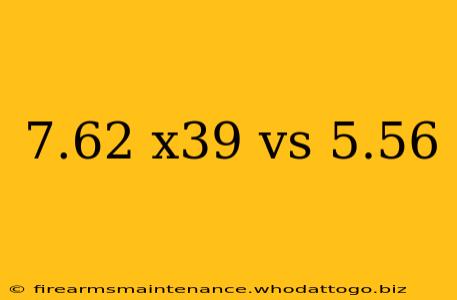Choosing the right caliber for your firearm is a crucial decision, impacting everything from accuracy and stopping power to recoil and ammunition cost. This in-depth comparison of the 7.62x39mm and 5.56x45mm NATO cartridges will help you understand the key differences and determine which is best suited to your needs. We'll explore ballistics, applications, and historical context to give you a comprehensive overview.
Ballistics: A Deep Dive into Performance
The fundamental difference between the 7.62x39mm and 5.56x45mm lies in their ballistics – the science of projectile motion.
7.62x39mm: The Heavyweight Contender
The 7.62x39mm, developed by the Soviet Union, is a relatively large and powerful intermediate cartridge. Its heavier bullet (typically around 123 grains) delivers substantial stopping power at close to medium ranges. Key ballistic characteristics include:
- Higher Recoil: The heavier bullet and larger cartridge case result in noticeably more recoil compared to the 5.56x45mm.
- Greater Stopping Power: Its larger, heavier projectile creates a larger wound cavity, offering more immediate incapacitation. This is particularly relevant in hunting or self-defense scenarios.
- Shorter Effective Range: While possessing good stopping power, its trajectory drops more significantly at longer ranges, reducing accuracy beyond 300-400 yards.
- Less Penetration: Compared to the 5.56, the 7.62x39mm often demonstrates less penetration through barriers like walls or vehicles, leading to less risk of overpenetration.
5.56x45mm NATO: Accuracy and Velocity
The 5.56x45mm NATO cartridge, developed by the United States, is a smaller, faster round. Its lighter bullet (typically around 55-62 grains) provides higher velocity and flatter trajectory. Key features include:
- Lower Recoil: The smaller bullet and cartridge case make it significantly easier to manage recoil, promoting faster follow-up shots.
- Flatter Trajectory: The high velocity results in a flatter trajectory, improving accuracy at longer ranges. Accurate shots can be achieved beyond 500 yards, dependent on shooter skill and environmental factors.
- Greater Penetration: The smaller, faster projectile exhibits greater penetration through barriers than the 7.62x39mm. While this offers advantages in some situations, it also poses increased risk of overpenetration.
- Less Stopping Power (Debated): Although debates persist, the 5.56's lighter bullet generally results in less immediate stopping power than the 7.62x39mm, necessitating more precise shot placement.
Applications: Where Each Caliber Excels
The ideal caliber depends heavily on its intended use.
7.62x39mm: Ideal Applications
- Hunting (smaller game): Effective for hunting deer-sized game at closer ranges.
- Self-defense: Offers substantial stopping power at shorter ranges.
- Military applications (some): Certain militaries still utilize 7.62x39mm weapons, though it's less prevalent than the 5.56.
- Cost-effective ammunition: Generally less expensive than 5.56x45mm ammunition.
5.56x45mm NATO: Ideal Applications
- Military applications: Widely adopted by NATO forces and many other militaries worldwide.
- Law enforcement: Used by law enforcement agencies globally for its accuracy and lower recoil.
- Sporting applications: Popular choice for target shooting, precision shooting, and three-gun competitions.
- Longer-range engagements: The flatter trajectory allows for more accurate shots at extended distances.
Ammunition Availability and Cost
Ammunition availability and cost are crucial considerations. The 7.62x39mm generally offers more affordable ammunition, making it a popular choice for those on a budget. However, the 5.56x45mm, though slightly more expensive, is widely available globally.
Conclusion: The Best Caliber for You
Ultimately, the "better" caliber – 7.62x39mm or 5.56x45mm – depends entirely on your individual needs and priorities. Carefully consider the ballistic differences, intended application, and cost factors before making your decision. Thorough research and potentially some range time with both calibers can help solidify your choice. This comparison provides a solid foundation for that process.

